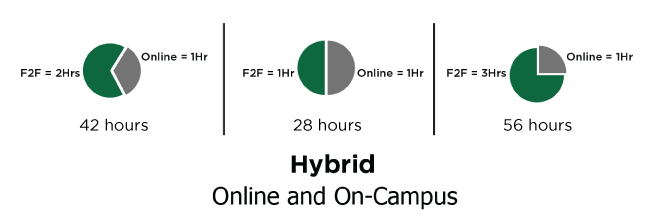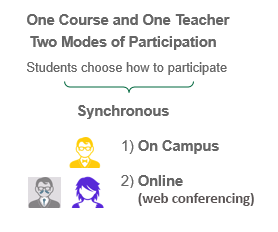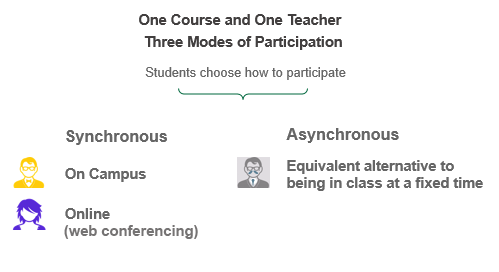Course and Program Delivery Modes
There are three main course delivery modes at Algonquin College: on-campus, online and hybrid.
Virtual delivery was introduced as “remote teaching” during the pandemic.
Multi-modal delivery was introduced at Perth and Pembroke campuses in Fall 2021 and will be piloted starting in Winter 2022. A form of multi-modal delivery has also been offered for several years by the Language Institute.
Click on each of the images to learn more about them.
 |
 |
 |
 |
 |
On-Campus Course Delivery
An on-campus course is delivered in the traditional classroom setting. This means that scheduled normative hours take place in the physical classroom. Classroom interaction takes the form of in-person, real-time interaction between the professor and the students, and encourages the use of technology-enabled teaching and learning at Algonquin College. An on-campus classroom provides many opportunities to present material to students using engaging educational technologies and tools. Educational technologies can create efficiencies by allowing students to collaborate, perform and complete learning activities and assessments in the physical classroom.
What Does On-Campus Delivery Look Like?
A typical 45 hour on-campus course will be taught for three hours per week over the course of a 15 week semester. These three hours may occur all at once in one three hour weekly classroom session, or be divided into one, 2 hour session and one, 1 hour session within a given week.
While an on-campus course takes place entirely in the physical classroom, Policy #AA42 requires that ALL courses make use of the Brightspace Learning Management System (LMS) to structure the course and convey key information to students.
Virtual Delivery
Virtual delivery is what we called “remote teaching” during the pandemic. It is teaching weekly scheduled classes via web conferencing – which means that that students do not need to be on-campus to attend.
What Does Virtual Delivery Look Like?
Virtual classes are delivered via Zoom – a web conferencing platform that supports web cam and microphone activity. Professors deliver lessons by sharing their presentation with students. Students can respond to questions by raising their hand (in the participant panel) and using their microphone, or they can provide text comments in the chat area. Small group discussion is facilitated through “break-out rooms” in which students can share their screen, and use their microphones, web cams and the chat feature to communicate. Other kinds of learning activities may include interactive polls, working on shared Microsoft Office documents, watching videos, brainstorming using the Zoom whiteboard or other tools such as Padlet.
Hybrid Course Delivery
A hybrid (or blended) course combines in-class instruction and activities with flexible, guided online learning in a virtual environment. Guided online activities in hybrid courses engage students with independent, active learning that is supported, performed or submitted via a course learning management system (LMS).
What Does Hybrid Delivery Look Like?
A hybrid course allows for many possible combinations of on-campus and online instruction, interaction and digital learning activities, as well as a wide variety of student deliverables.
A hybrid course equates to a weekly balance of:
- 42 Hour Hybrid Course = 2 hours F2F per week + 1 hour Online per week
This pattern occurs on a weekly basis for the duration of the academic term. Other hybrid course structures are also possible depending on the program such as: - 28 Hour Hybrid Course = 1 hour F2F per week + 1 hour Online per week
- 56 Hour Hybrid Course = 3 hour F2F per week + 1 hour Online per week
In all cases, consistent weekly distribution and engagement with technology provides students with learning activities that accommodates and supports a diversity of learning styles.
There are many ways that hybrid learning activities can be introduced into your course such as:
- Collaboration (discussion forums, blogs, social media, wikis)
- Reflection (e-portfolios, WordPress, Animoto)
- Gamification (Quizlet, Kahoot!, Socrative, Quizizz)
- Interactive Learning (Padlet, H5P)
Algonquin College’s hybrid courses have begun to apply elements of a quality assurance framework (Quality Matters) to enhance student learning in the online portion of the course.
Curated Resources
Find a comprehensive list of support resources.
Hybrid Course Design and Delivery
If you would like assistance in creating an engaging hybrid course, please book an appointment with an LTS consultant.
Online Course Delivery
An online course means that scheduled normative hours take place outside of a physical classroom. They provide students with flexibility to personalize their study schedules as the course teaching and learning activities occur online through the use of the Brightspace Learning Management System. Students complete assessments, submit assignments and collaborate on projects using a wide range of educational technologies and digital learning activities.
What Does Online Delivery Look Like?
Algonquin College’s online courses integrate a quality assurance framework (Quality Matters) to enhance student learning and foster an approach for continuous improvement in virtual environments. Many of Algonquin College’s fully online courses include key elements such as: Course Overview and Introduction, Learning Objectives and Competencies, Assessment and Measurement, Instructional Materials, Learner Interaction and Engagement, and Course Technology.
Multimodal Course Delivery
Multimodal delivery provides the learner with a flexible choice to participate in their course either on-campus or virtually.
Professors commonly teach to on-campus and virtual student audiences simultaneously.
What Does Multi-modal Delivery Look Like?
Common multi-modal formats include BlendSync and HyFlex
BlendSync
In this format, all students participate in regularly-scheduled classes synchronously. They choose whether to attend class on-campus or virtually via web conferencing.

HyFlex
HyFlex is a more advanced format option – since a teacher is managing their presence across three different participation modes at the same time. Like BlendSync, learners can choose to participate in regularly scheduled classes synchronously – either on-campus or virtually via web conferencing. However, they can pursue a third choice – asynchronous – which would be an alternate option.
